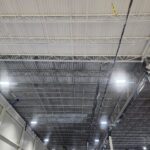
Photos @bigstockphoto
In metal building systems, the importance of proper insulation and moisture control cannot be overstated. One of the key elements in achieving this is the use of vapor barriers. When installed correctly, vapor barriers significantly reduce condensation problems and minimize air leakage, ultimately leading to enhanced building performance and longevity.
By installing a vapor barrier the metal building performance dynamic will increase and last longer. Without this, water or moisture can be trapped in the wall producing moisture and other problems such as mold, rot, and thermal performance issues. The question is, how are today’s vapor barriers ensuring air tightness and how is this different from an air barrier?
Air Barrier vs. Vapor Barrier
An air barrier’s function is primarily to stop air leakage and resist differences in air pressure by keeping the indoor climate regulated. Simply put, air barriers keep the outdoor air out and the indoor air in. An air barrier should be:
- durable enough to withstand construction pressures and handling
- impermeable to airflow
- continuous, enclosing, or enveloping the entire conditioned space
While air barriers are key to limiting the airflow in and out of a living space, it is important to note air from either a conditioned or an unconditioned side may still find its way into walls. So, even though it is critical for a living space to have walls that are as airtight as possible, the assembly of the wall itself should always be moisture vapor permeable to allow for incidental moisture to escape, or diffuse, rather than be trapped and make the structural materials of the wall wet.
On the other hand, a vapor barrier’s most important function is to be impermeable to moisture in vapor form, thereby preventing the movement of water vapor through the wall cavity from going outside and vice versa.

Protecting the envelope
A vapor barrier is a material designed to prevent moisture from penetrating through walls, ceilings, and floors. Metal buildings can be susceptible to temperature fluctuations and humidity, and vapor barriers play a crucial role in maintaining the integrity of the structure. By controlling the movement of water vapor, these barriers prevent condensation from occurring within the building envelope.
When condensation happens, warm, moist air comes into contact with a cooler surface, such as the metal walls or roof of a building. This can lead to a host of problems, including corrosion, mold growth, and deterioration of the building materials. By installing a vapor barrier, the movement of moisture-laden air is restricted, reducing the chances of condensation forming on these surfaces.
Manufacturers are making it a priority to ensure vapor barriers are ensuring air tightness. One way is using is a smart vapor retarder designed to enhance the energy efficiency of buildings by effectively managing moisture levels. These insulation systems provide a continuous air barrier, adapt to changes in humidity so that moisture can escape, and remain tight to prevent moisture from entering.*
Building functionality
By reducing air leakage, the vapor barrier contributes to improved energy efficiency, lower utility costs, and a more comfortable indoor environment.
By hindering the intrusion of outside air, these barriers help to maintain consistent indoor temperatures and reduce the risk of moisture-laden air entering the building. This is particularly important in metal buildings, where moisture can be trapped within walls, leading to issues such as mold growth, wood rot, and a decline in thermal performance.

Facing consequences
Metal structures are increasingly recognized as reliable, durable, sustainable, energy-efficient, and cost-effective. At one time, a standard for warehouses, distribution centers, and industrial projects, metal building systems have evolved to include commercial office buildings, retail storefronts, and even residences.
Some may feel barriers are unnecessary because of these strengths; however, what may seem like a cost-saving measure at the time can wreak havoc in the future.
If a vapor barrier is not correctly installed, a metal building is at risk. Improper use or installation can occur when a properly certified contractor is not hired for the job. Incorrect installation of a vapor barrier can allow moisture to penetrate walls, foundations, and subfloors. When insulation behind walls becomes wet, it loses its R-value, reducing the building’s energy efficiency. Additionally, trapped moisture within the structure can lead to mold and mildew buildup, affecting the building’s occupants. Over time, these moisture issues may cause the structure to deteriorate and eventually fail.*
Barrier best practices
Today’s vapor barriers are designed with advanced materials that provide superior moisture resistance and air-sealing capabilities. These barriers are often made from polyethylene or other durable, impermeable materials. When installed correctly, they create a continuous barrier that effectively blocks the passage of both air and moisture.
To ensure effectiveness, vapor barriers must be installed according to manufacturer guidelines and industry best practices. This includes sealing all seams, edges, and penetrations and ensuring that the barrier is properly positioned within the building envelope.
In some cases, it may be necessary to use additional sealing materials, such as tapes or adhesives, to achieve a complete and airtight seal. The choice of vapor barrier material and installation method may vary depending on the specific climate and building design, so research is imperative.
Environmental initiatives
A deep energy retrofit is a comprehensive, whole-building strategy to optimize energy performance in an existing building or home. Optimizing building performance standards in restoration all starts with creating an airtight enclosure. Other building upgrades, such as continuous insulation (ci), high-performance windows and doors, shading, renewable energy sourcing, efficient HVAC, and domestic hot water distribution, are all major contributors to a deep energy retrofit.
The role of vapor barriers in metal buildings frequently bears repeating. By preventing condensation, reducing air leakage, and protecting against moisture-related problems, vapor barriers contribute to the long-term performance and durability of the structure. As project materials and architectural techniques continue to evolve, today’s vapor barriers are more effective than ever, ensuring airtightness and enhancing metal buildings’ overall efficiency and lifespan.





